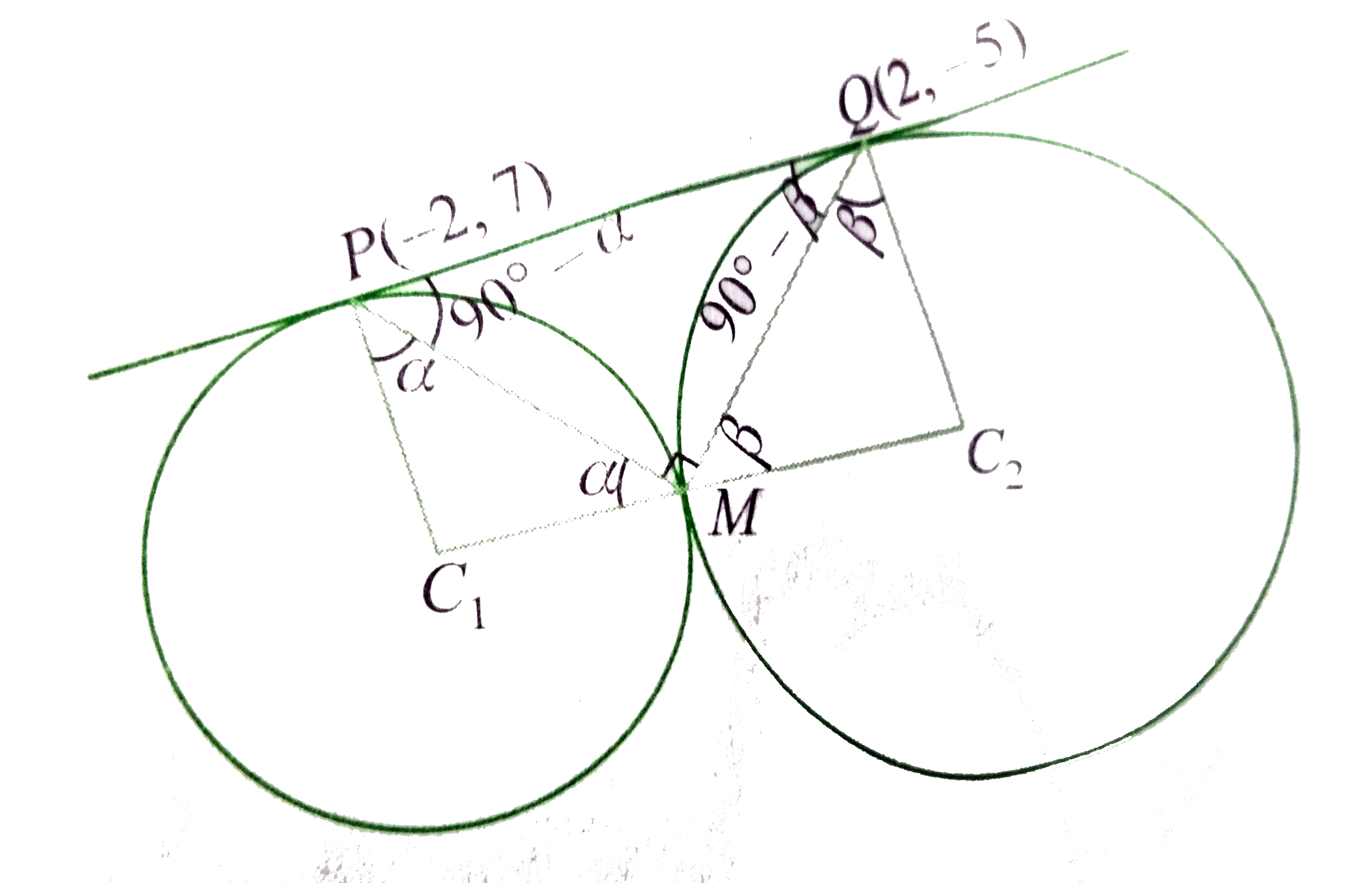Let T be the line passing through the points P(−2, 7) and Q(2, −5) . Let F1 be the set of all pairs of circles (S1, S2) such that T is tangent to S1 at P and tangent to S2 at Q , and also such that S1 and S2 touch each other at a point, say, M . Let E1 be the set representing the locus of M as the pair (S1, S2) varies in F1 . Let the set of all straight lines segments joining a pair of distinct points of E1 and passing through the point R(1, 1) be F2 . Let E2 be the set of the mid-points of the line segments in the set F2 . Then, which of the following statement(s) is (are) TRUE? The point (−2, 7) lies in E1 (b) The point (45,75) does NOT lie in E2 (c) The point (12, 1) lies in E2 (d) The point (0,32) does NOT lie in E1
The point (−2,7) lies in E1
The point (4/5,7/5) does NOT lie in E2
The point (1/2,1) lie in E2
The point (0,3/2) does NOT lie in E1
The correct Answer is:2,4
According to the question , we have the following figure :

Clearly, ∠PMQ=π2.
Hence, locus of M is
(x+2)(x−2)+(y−7)(y+5)=0
or E1≡x2+y2−2y−39=0 (i)
Clearly, E2 is the locus of mid-points of chords of E1 passing through (1,1).
Let the mid-pioint of chord of E1 be (h,k) .
Its equation is
h+k−(1+k)−39=h2+k2−2k−39
or h2+k2−2k−h+1=0
Hence, E2≡x2+y2−x−2y+1=0 (ii) ltbrlt Operation (A) is incorrect, although, it satisfies eq. (i) otherwise the line T would touch the second circle at two points.
Als, (4/5,7/5) satisfies eq. (ii) but again in this case one end of the chord would be (−2,7) which is not included in E1.Therefore, (4/5,7/5) does not lie in E2
(12,1) does not satisfy eq. (ii), therefore, it does not lie in E2.
(0,3/2) does not satisfy eq. (i), so it does not lie inE1.
Topper's Solved these Questions
Similar Questions
Let S be the set of circles x2+y2=r2 for r=1, 2 and 3 and T be the set of lines y=x+k√2 for k=0,≠1and±2. Find the number of distinct points of intersection of the graphs of set S and T.
View SolutionLet S1 and S2 be two circles. S1 is tangent to x-axis and S2 is tangent to y axis and the straight line y = mx touches both circle at their common point. If centre of the circle S1 is (3,1), then radius of circle S2 is p/q, Find the least value of (p+q)
View Solution
Knowledge Check
Let T be the line passing the points P(–2, 7) and Q(2,–5). Let F1 be the set of all pairs of circles (S1,S2) such that T is tangent to S1 at P and tangent to S2 at Q, and also such that S1 and S2 touch each other at a point, say M. Let E1 be the set representing the locus of M as the pair (S1,S2) varies in F1. Let the set of all straight line segments joining a pair of distinct points of E1 and passing through the point R(1,1,) be F2. Let E2 be the set of the mid-points of the line segments in the set F2. Then, which of the following statment(s) is (are) TRUE ?
AThe point (–2,7) lies in E1BThe point (45,75) does NOT lie in E2CThe point (12,1) lies in E2DThe point (0,32) does NOT lie in E1Let T be the line passing through the points P(-2, 7) and Q(2, -5). Let F1 be the set of all pairs of circles (S1,S2) such that T is tangent to S1 at P and tangent to S2 at Q, and also such that S1andS2 touch each other at a point , say M. Let E1 be the set representing the locus of M as the pair (S1,S2) varies in F1. Let the set of all straight line segment joining a pair of disntinct point of E1 and passing through the point R(1, 1) be F2. Let E2 be the set of the mid-points of the line segments in the set F2. Then , which of the following statement (s) is (are) TRUE?
AThe point (-2, 7) lies in E1BThe point (45,75) does NOT lie in E2CThe point (12,1) lies in E2DThe point (0,32)does NOT lie in E1Let S be the set of all real values of λ such that a plane passing through the points (−λ2,1,1),(1,−λ2,1)and(1,1,−λ2) also passes through the point (−1,−1,1). Then, S is equal to:
A{√3,−√3}B{3,3}C{1,−1}D{√3}
Let S be a set of all distinct numbers of the form pq, where p, q∈{1,2,3,4,5,6}. What is the cardinality of the set S
View SolutionIf S is the set of all straight lines and relation R is defined on S as T={(S1,S2):S1 is perpendicular to S2} then R is
View SolutionLet P be the set of prime numbers and S = { t : 2t−1 is a prime}. Then,
View SolutionLet S be the set of all values of x for which the tangent to the curve y=f(x)=x3−x2−2x at (x,y) is parallel to the line segment joining the points (1,f(1)) and (−1,f(−1)), then S is equal to :
View SolutionA particle is observed from two frames S1andS2. The frame S2 moves with respect to S1 with an acceleration a. Let F1andF2 be the pseudo forces on the particle when seen from S1andS2 respectively. Which of the following are not possible ?
View Solution
